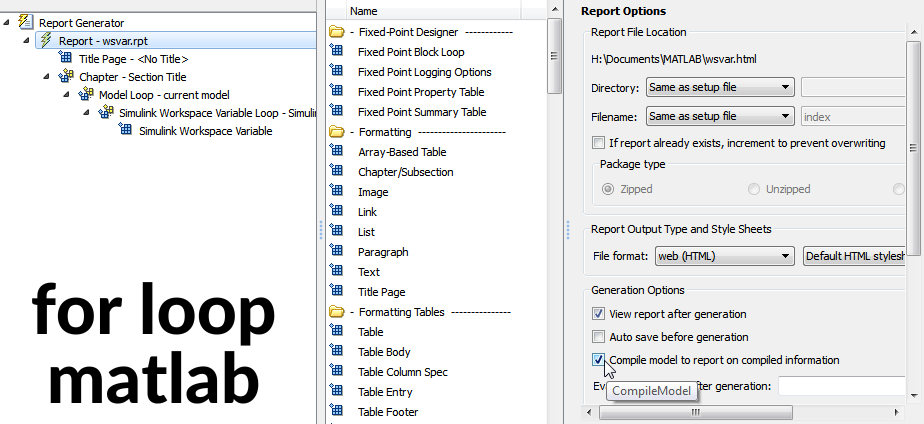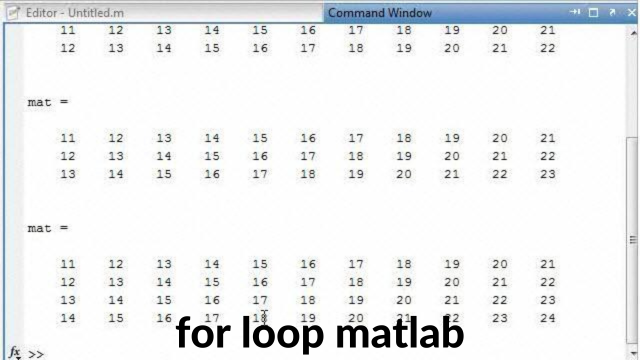A “for loop matlab is a fundamental programming concept that helps repeat specific tasks multiple times in an organized way. If you’re working on MATLAB, understanding how to use a for loop can make your code much more efficient and easier to manage. Whether you’re dealing with data processing, automation, or creating complex programs, the for loop is an essential tool in your coding toolbox. In this article, we will explain everything you need to know about loops in MATLAB, including their syntax, how they work, and their real-world applications.
What Is a For Loop in MATLAB?
A for loop matlab is a control flow statement that allows you to repeat a set of commands a specified number of times. This makes it an invaluable tool when you need to perform repetitive tasks, such as processing data in an array or iterating over a range of values. When you define a for loop, you provide the range of values over which you want the loop to iterate and the set of instructions that should be repeated during each iteration.
For example, a simple for loop can help calculate the sum of numbers from 1 to 10 or perform more complex operations like matrix multiplication or data analysis. Automating repetitive tasks, for loops can save you time and make your code cleaner and more efficient.
How Do For Loops Work in MATLAB?
In MATLAB, the for loop works by iterating over a specified range of values and performing the same set of commands for each value in the range. The general structure of a for loop includes:
- Initialization: Defines the starting value of the loop variable.
- Condition: Determines the stopping condition, or how many times the loop will run.
- Increment/Decrement: Defines how the loop variable changes after each iteration.
Each time the loop runs, the loop variable is updated, and the commands inside the loop are executed. Once the loop variable reaches the stop condition, the loop exits and the program continues executing the remaining code.
For instance, the loop might count from 1 to 5, running a command five times with the loop variable being incremented by 1 each time.
Why Use For Loops in MATLAB?
Using loops in MATLAB allows you to automate repetitive tasks and make your code more efficient. Instead of writing the same line of code multiple times, you can place that line inside a for loop and let the loop handle the repetition for you. Here are a few reasons to use for loops in MATLAB:
- Efficiency: Reduces the need for repetitive code, making your program more compact.
- Automation: Automates tasks like data processing, computation, and matrix operations.
- Improved readability: Makes your code easier to understand by reducing redundancy.
Loops are especially helpful in working with large datasets or complex calculations that require repeated operations over a range of values.

The Basic Syntax of a For Loop in MATLAB
The basic syntax of a for loop in MATLAB follows this structure:
Matlab
Copy code
for loop_variable = start_value:end_value
% Command(s) to execute
end
- loop_variable: The variable that controls the loop.
- start_value: The initial value of the loop variable.
- end_value: The final value of the loop variable.
- Inside the loop, the set of commands is executed repeatedly.
Here’s a simple example of a for loop that prints numbers from 1 to 5:
Matlab
Copy code
for i = 1:5
Disp(i)
end
This loop will display the numbers 1 through 5 in the MATLAB console.
Example of a Basic For Loop
Let’s look at another example where we use a for loop to calculate the sum of numbers from 1 to 10:
Matlab
Copy code
sum = 0;
for i = 1:10
sum = sum + i;
end
Disp(sum);
In this example, the loop runs 10 times, and each time it adds the current value of i to the variable sum. At the end, the sum holds the total, which is 55 (the sum of numbers 1 through 10).
Common Mistakes to Avoid in Loops
While loops are simple to use, they can lead to some common mistakes. Here are a few to watch out for:
- Incorrect loop ranges: Be mindful of the starting and ending values. If you set an invalid range, the loop may not execute at all.
- Off-by-one errors: These occur when the loop variable doesn’t cover the desired range of values. For example, if you want to count from 1 to 10, but mistakenly write for i = 1:9, it will only count from 1 to 9.
- Unintended infinite loops: If you forget to update the loop variable inside the loop, the loop might run forever.
By carefully checking your loop’s range and ensuring the loop variable updates correctly, you can avoid these common pitfalls.
Here’s a general structure for a “Bio Table” that you can use to organize biographical information. The format can be adjusted depending on the type of biography you’re writing about (individual, company, project, etc.):
| Field | Description |
|---|---|
| Name | [Full Name] |
| Date of Birth | [Birth Date] |
| Nationality | [Nationality] |
| Occupation | [Current Occupation] |
| Education | [Educational Background/Institution(s)] |
| Skills | [Key Skills or Areas of Expertise] |
| Experience | [Relevant Professional Experience] |
| Achievements | [Key Achievements or Awards] |
| Publications | [Books, Articles, or Other Published Works] |
| Contact | [Contact Information] |
| Social Media | [Links to Social Media Profiles (LinkedIn, Twitter, etc.)] |
You can adapt this table by adding or removing fields depending on the specifics you need. If this isn’t the type of bio table you were referring to, let me know how I can tailor it further!
Writing a For Loop with Multiple Commands
For loops are powerful because they can execute multiple commands within each iteration. To do this, you simply place the commands you want to repeat inside the loop. Here’s an example that demonstrates this:
Matlab
Copy code
for i = 1:5
Disp([‘Iteration ‘, num2str(i)]);
result = i^2;
Disp([‘The square of ‘, num2str(i), ‘ is ‘, num2str(result)]);
end
In this example, the loop displays the current iteration number and the square of each number from 1 to 5.
For Loops and Arrays in MATLAB
Arrays are a central feature of MATLAB, and loops are often used to iterate over the elements of an array. For example, you might want to apply a function to each element of an array or modify the values of an array based on a condition. Here’s an example of iterating over an array:
Matlab
Copy code
A = [1, 2, 3, 4, 5];
for i = 1:length(A)
disp([‘Element ‘, num2str(i), ‘ is: ‘, num2str(A(i))]);
end
In this case, the loop goes through each element of the array A and displays its value.
Nested For Loops in MATLAB
A nested for loop is a loop within another loop. This is useful when you need to perform a task that involves multiple iterations over two or more sets of data. For example, if you need to work with a 2D array (a matrix), you can use nested loops to iterate over both the rows and the columns.
Here’s an example of a nested for loop that sums the elements of a 2D array:
Matlab
Copy code
A = [1 2 3; 4 5 6; 7 8 9];
sum = 0;
for i = 1:size(A,1)
for j = 1:size(A,2)
sum = sum + A(i,j);
end
end
Disp(sum);
This code sums all the elements of the matrix A using nested loops.

How to Write Nested Loops in MATLAB
Writing nested loops in MATLAB follows the same basic syntax as a regular for loop, but you simply place one loop inside another. You need to ensure that the inner loop runs completely for each iteration of the outer loop. This can quickly increase the complexity of your program, especially for large datasets.
Use of Nested For Loops in Data Processing
Nested-for loops are extremely useful in data processing tasks where you have to deal with multi-dimensional arrays or perform operations that require iteration over different dimensions. For instance, if you’re processing image data (which is often represented as a matrix of pixel values), nested loops can help iterate over the rows and columns to apply filters or perform calculations.
Tips for Using For Loops Efficiently in MATLAB
Here are some tips to optimize your use of for loops in MATLAB:
- Pre-allocate arrays: Before using a for loop to assign values to an array, pre-allocate the array’s size. This prevents MATLAB from dynamically resizing the array, which can slow down performance.
- Vectorization: Whenever possible, try to vectorize your code instead of using for loops. MATLAB is optimized for vector operations, and using them can greatly improve performance.
- Break early: If you know the loop can stop before reaching the maximum number of iterations, use the break statement to exit early.
Basic Syntax of a ‘For’ Loop
The basic syntax of a for loop in MATLAB is straightforward. You specify a loop variable, its range, and the commands you want to repeat within the loop. The loop will iterate through the defined range and execute the commands for each iteration.
Example syntax:
Matlab
Copy code
for variable = start_value:end_value
% Code to execute
end
The Bottom Line
In summary, the for loop is one of the most essential tools in MATLAB programming. Whether you’re working with arrays, matrices, or large datasets, the ability to iterate over values and repeat tasks efficiently can greatly simplify your coding process. By understanding the basics of for loops, how to use them in various situations, and avoiding common mistakes, you can write more efficient and effective MATLAB code. Remember to experiment with nested loops, multiple commands, and array processing to unlock the full potential of MATLAB’s looping capabilities.














Got a Questions?
Find us on Socials or Contact us and we’ll get back to you as soon as possible.